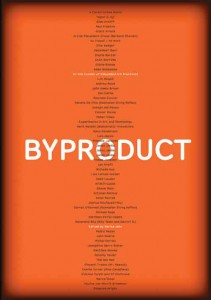« Face to Face
Embedded Art Practices
A Conversation between Marisa Jahn and Joseph del Pesco
On the occasion of the launching of Byproduct: On the Excess of Embedded Art Practices, published by YYZ BOOKS and REV, we have invited the editor, artist, and writer Marisa Jahn, and Joseph del Pesco, Program Director of Kadist Art Foundation in San Francisco, one of the contributors to discuss contemporary art practices ‘embedded’ in cultural industries, governmental institutions and other non-art sectors.
Joseph del Pesco - Marisa, you open the book with a personal note indicating that there are more individuals and groups than you were able to include. One might think of this kind of information overflow as a byproduct of your research. Some were examples you chose to leave out, but others were stories or histories you either couldn’t fit into the pages, found too late, or couldn’t find enough information about. What are some of these byproducts?

Marisa Jahn, editor of Byproduct: On the Excess of Embedded Art Practices, published by YYZ BOOKS and REV, 2011.
Marisa Jahn -There are a few kinds of individuals and groups whose embedded practices I couldn’t cover.
For one, I didn’t cover projects initiated by institutions that sought to embed artists in non-art contexts. Examples include the artist-in-residency projects in the late 60’s/early 70’s by Xerox Parc in Palo Alto, Los Angeles County Museum of Art, and CAVS at MIT. While I think these are all important and fascinating moments in transdisciplinary work, in Byproduct I wanted to focus on projects in which individuals had approached institutions where they sought to embed themselves. What I saw was that when institutions sought to embed individuals in non-art contexts, there was a certain amount of scholarship dedicated to contextualizing these works; this critical attention was lacking in most of the selections I featured. Also, when an individual decides to approach an institution, there is a certain admirable chutzpah or gall involved. It’s this kind of miraculous and laudable got-nothing-to-lose attitude that engenders political and social change.
Second, I also mainly featured artists from North America; for a second edition of the book I’d love to include examples of embedded practices from different parts of the world. This choice was mainly due to limited resources: while I had some good leads, I simply didn’t have the funds to learn firsthand about projects outside of North America. I’ve found that due to the nature of embedded art practices, it is important to understand the nuances of the projects’ contexts. Oftentimes for the artist who is embedded, if he is documenting his work, it’s impossible, by virtue of his position, to garner a different kind of-maybe ethnographic-perspective. The artist is a foreign element introduced as a counterpoint to the system. The funny thing here is that you then need to add an outsider to this matrix to get a clear perspective, and now you have a recursive system of always needing an outsider (or parasite). This is pointed out by Michel Serres in a text included in the book.
But to return to your question about what projects I was not able to include; I was a little hesitant about covering projects that I couldn’t see firsthand or whose contexts weren’t already familiar. For example, I really wanted to involve the work of Disonancias, a group in Bilbao, Spain, which has been placing artists in industries and the government for at least four years now. When I was editing Byproduct, I researched their project descriptions online, but I couldn’t get a feel for how the hosting institutions felt about the projects that took place. Was there any tension between the embedded artists and their hosts? Did the projects retain a degree of criticality, or were they completely instrumentalized? Reading the reviews in international publications didn’t help answer these questions; these reviews were mostly laudatory and didn’t go into the subtleties of what are often agonistic relationships. In cases like these, it was important for me to understand more of the context surrounding these embedded practices, but I wasn’t able to extend my research outside of North America. Since publishing Byproduct, I was able to meet Arantxa Mendiharat, one of the principal organizers of a related group called ‘Conexiones Improbables’ with a renewed focus on embedding artists in industries and the government in Spain. I’d love the opportunity to include these initiatives in future editions.

Joseph del Pesco, Program Director of Kadist Art Foundation in San Francisco, California and contributor to Byproduct.
A third kind of project I was unable to include was those few examples where artists embedded in governmental entities did not feel comfortable participating in the book without first knowing how subversive or biased the book was going to be. I think they were uncomfortable being associated with The Yes Men. Others voiced concern that my invocation of the word ‘parasite’ was too pejorative and would compromise the relationship with their host. It should be noted that in Byproduct, I spent a long time reviewing and introducing this term, revealing its positive aspects. Per the research of biologists, we now understand that parasites have an alimentary (nourishing) relationship with their hosts, and my stance was that this foreign element when introduced is often quite productive. As I see it, the concerns of those who were initially hesitant may be assuaged after seeing this first edition and their projects might be included in subsequent editions.
I also recognize the limitations of my purview and invite others to share with me examples of embedded art practices. What are some examples that you, Joseph, think might be interesting to include in a subsequent volume?
CREATIVE PRODUCTIONS AND EXPERIMENTATION
J.d.P. -I was just talking with Jon Rubin about his Conflict Kitchen, a project he organized with Dawn Weleski in Pittsburgh, PA. It’s a street-level window that only serves food from countries that the U.S. is in conflict with. It’s a very simple operation, but in the context of the culinary offerings of Pittsburgh, it has had quite an impact. So far they’ve served Kubideh from Iran and Bolani from Afghanistan. What’s interesting for our conversation though is that the Conflict Kitchen is run out of the back door of another initiative called the Waffle Shop, organized by Rubin and a group of students as part of his work as a professor at Carnegie Mellon University. The Waffle Shop is also a reality-television-style talk show that is broadcast in real time on their website. The Waffle Shop is a real business and makes enough money to pay a staff, but it is also backed by the University. The students learn through creative production and experimentation in the shop and its media programming. The Conflict Kitchen, however, is a parasite or byproduct of the Waffle Shop. It’s an unusual case where the artist not only negotiated his own relationship to a host, but also established the host. And the idea of ‘host’ here is further complicated by the role of the University, but not in the way you might think. The Conflict Kitchen has been so wildly successful from a PR standpoint that the University has asked Rubin to become more closely associated with it. For the time being, the project has maintained its (relative) autonomy. A food-service company, which provides not just ingredients but entire restaurants (food programs) to a number of different universities, has expressed an interest in having the Conflict Kitchen become part of their program, but Rubin and Weleski are being very careful to protect the critical content. They’re insisting on the inclusion of some of the cultural programming surrounding the project, such as live Skype exchanges with filmmakers in Iran and Afghanistan. The information-rich ‘packaging’ of the Conflict Kitchen storefront and food wrappers is a crucial component of the conceptual framing of the project and would also have to be translated into new domains.
Considering for a moment the packaging of the Byproduct book, I like how the designer chose to fade the edges, like those of a photocopied page, to separate the reprinted and historical material from more recent content and content developed or edited specifically for the book. How do you feel this historical material operates within the framework of the book?
M.J. -I’m quite fond of this feature myself. The designer, the talented Ryan Hines, came up with the shading to set apart the contextualizing essays and manifestos.
Of the contextualizing essays that were reprinted, some of them are quite challenging or disciplinarily specific. But they are canonical texts that strengthen the discourse surrounding embedded art practices. In terms of interacting with these texts, you don’t have to understand them completely to get something out of them. For example, I’ve included an essay by the philosopher John Searle entitled “What is an institution?” This selection explains how institutions exist as mutually agreed upon systems of belief regarding an organizational entity. While his work is contentious, I felt it was an important essay, because it says in linguistic terms what many embedded artists put into practice. I also included an excerpt of a book by Michel Serres. Serres is a theorist whose poetic sensibility and philosophical import is undervalued in the Anglophone art world. He’s better known to cultural theorists and architects and I’m a little baffled why his texts haven’t been more readily introduced to contemporary artists. I included excerpts of his seminal book Parasite, because it was extremely helpful to me in thinking about embedded art practices. Side by side, the Searle and the Serres texts describe two unavoidable characters-the institution and the host-upon which embedded art practices are predicated.
Also, the texts vary in terms of style and discipline. As such, they help delineate the contours of this subgenre of work we are calling embedded art practices. Even if you disagree with them, they provide something to work with. The manifestos by artists working in the late 60’s and onward-Billy Kluver (co-founder of Experiments in Art and Technology), Barbara Steveni (co-founder of Artist Placement Group), John Seely Brown (founder of the artist-in-residency program at Xerox Parc)-put forth some very progressive ideas. I wanted to make sure that those working as embedded artists were aware of these historical antecedents.
J.d.P -You’ve invested heavily in the format of interviews and conversations for this book. Even the introduction starts in the margins and grows into a meta-textual conversation between you and Larry. Having known you for a while, I know that disrupting conventions is built into your politics, and also perhaps to a different extent to your attitude toward cultural production. How did you choose interview/conversation as the primary format for Byproduct?
M.J. -For me, interviews can comfortably slide in and out of being formal/academic and colloquial/conversational. This weaving can introduce an element of humor, and also permit those speaking to restate things in more frank terms than academic prose allows. I enjoy interviewing others because I can preserve their voices and have them say things in their own terms.

A Constructed World, Altamont, 1969-2009 (“Tableau vivant” recreated by one hundred and twenty employees of BNP at CNEI, Chatou, France), 2009. Photo: Sébastien Agnetti.
As for the introduction, which was written in three voices, I’ve also written a few other texts in the same way. My master’s thesis at MIT was written in three voices-a diaristic voice, an academic or interpretive (exegetical) voice, and a third voice that is the voice of an obsessive Victorian pervert. Writing in this dissociated fashion allows me to be the academic and also make fun of myself and play the role of the class clown or critic.
In terms of process, for Byproduct I first wrote the introduction as an academic text. I then went back and dug into the more dense parts of it, creating a character with my own name to ask really basic questions that people would be to embarrassed to ask in an academic context, but that are important clarifying questions. I then invited Larry Bogad to disrupt the text, and he came up with the brilliant idea of starting from the footnotes and having them take over the main text.
The interview format and the meta-textual conversation aren’t driven from the desire to be unconventional; they come from having discovered a practical format to solve my concerns, inject humor, and express things more aptly.
In your curatorial work, you are known for developing creative frameworks to showcase the artwork of others. One of these ways is by valuing already existing forms of communication-like the anecdote, the conversation, hearsay-as relevant and in fact critical media of discourse. As I see it, many embedded art practices evade traditional forms of institutional validation and rely on a one-to-one level of broadcast, or what Stephen Wright refers to as a rumor economy. This form of communication remains highly intimate and retains a degree of creativity in interpretation. I am wondering, Joseph, how and what you see as the role of these more intimate forms of communication in relation to embedded art practices?
J.d.P. -This mode of supporting an intimate kind of relationship to ideas, objects and situations, and to the extended cloud of content that exists around their production and presentation is, I would suggest, one crucial way that art stands apart from other forms of mass production. This may be most visible in the eye of the storm, where a given embedded artist is surrounded by the mechanisms and attitudes of another (potentially hostile) culture, be it judicial culture or corporate culture. The artist’s culture is, in these cases, too often identified as a weak or poor form of the same culture, instead of as an alternate culture or at least a fully formed mutation.
In some of our earliest conversations about this book, we were thinking about embedded projects that despite starting in the art world, had merged or metastasized, or that, in other words, took on a life of their own. The idea that one culture (the artists) could integrate with another (business, government, etc.), or that aesthetic production could transition into usefulness might be recognized as a living byproduct. Later we started thinking in more specific and targeted ways about artists embedded in various sites and organizations that had explicitly utilitarian aims. Did we lose anything in the shift? Are there some projects where both apply?
M.J. -Yes, in our first conversations guiding this book, we considered that a way to gauge the ‘success’ of an embedded art practice is to note when it became fully ‘assimilated’ into everyday life. This raises the question of when an embedded practice stops being ‘embedded’ and just becomes, well, life? I think the more relevant line of inquiry is the ways in which a work of art has a double ontological status (a designation as art as well as another designation or use in a different sphere/discipline/world). This second question more aptly embraces notions of difference (alterity) and the role of a thing in possessing variegating kinds of value.
As for the question about art vs. utility and the question about artistic autonomy, recent experiences have caused me to consider things anew. My own training is in the arts as a writer and artist with curatorial tendencies; at the same time, for the past 15 years I’ve been involved politically with various groups as an organizer and educator. These two backgrounds have not necessarily overlapped. In the past few years, however, I’ve been working as an artist embedded in different civil liberty and economic justice advocacy organizations. When I was working with the Street Vendor Project, a New York City-based vendor advocacy organization, I started involving artistic approaches in our campaigns and work because it helped us achieve our goals of reaching new audiences on the street and through the media. I’m now working as the director of an organization called People’s Production House (PPH). PPH is a journalism training and production institute; we teach low-wage workers, immigrants, and young people to produce news media intended for both general and special interest audiences. In all these groups, the ‘art’ that I’ve helped produce (with PPH as well as the varying advocacy groups) ranges from being straight-up propaganda (helping to design flyers and protest signs) to design in service of the organization (redesigning their logos) to conceiving of projects that are less tied to immediate aims. Now, art purists would raise the question of whether the work I’m doing is just advocacy or design and say that it’s tendentious. I’m not so concerned about the labeling of what it is that I do; in my mind I’m using my training in the arts to help craft and lead culturally-relevant campaigns that catalyze social or political momentum.




































